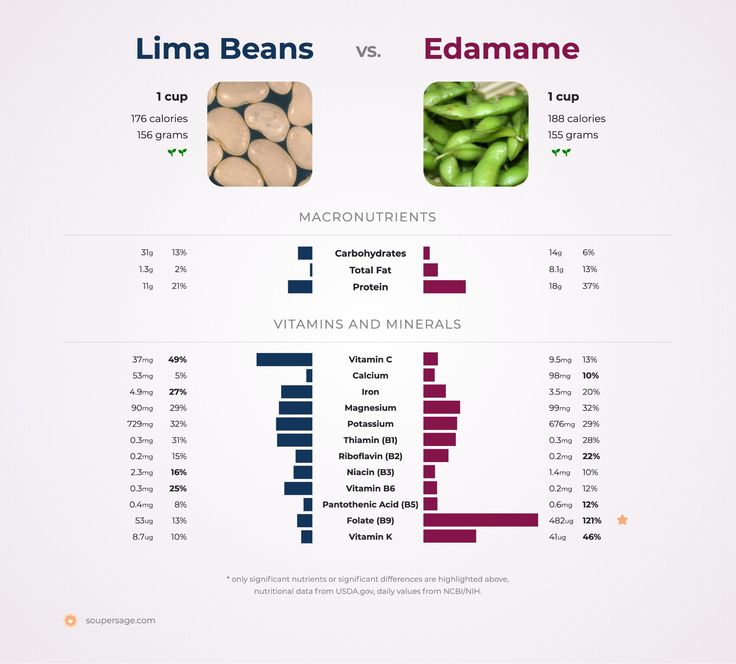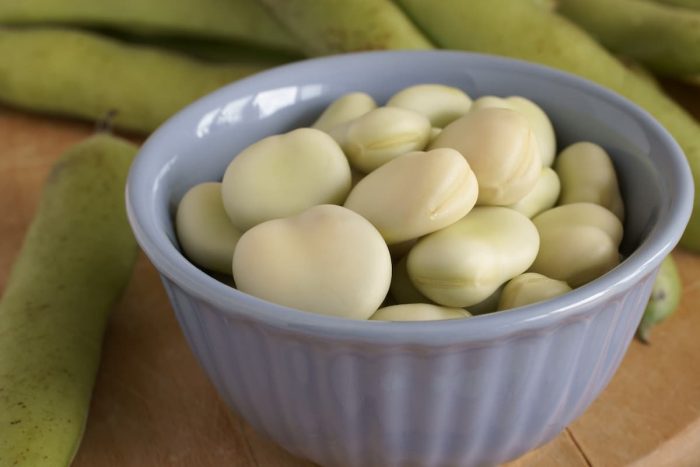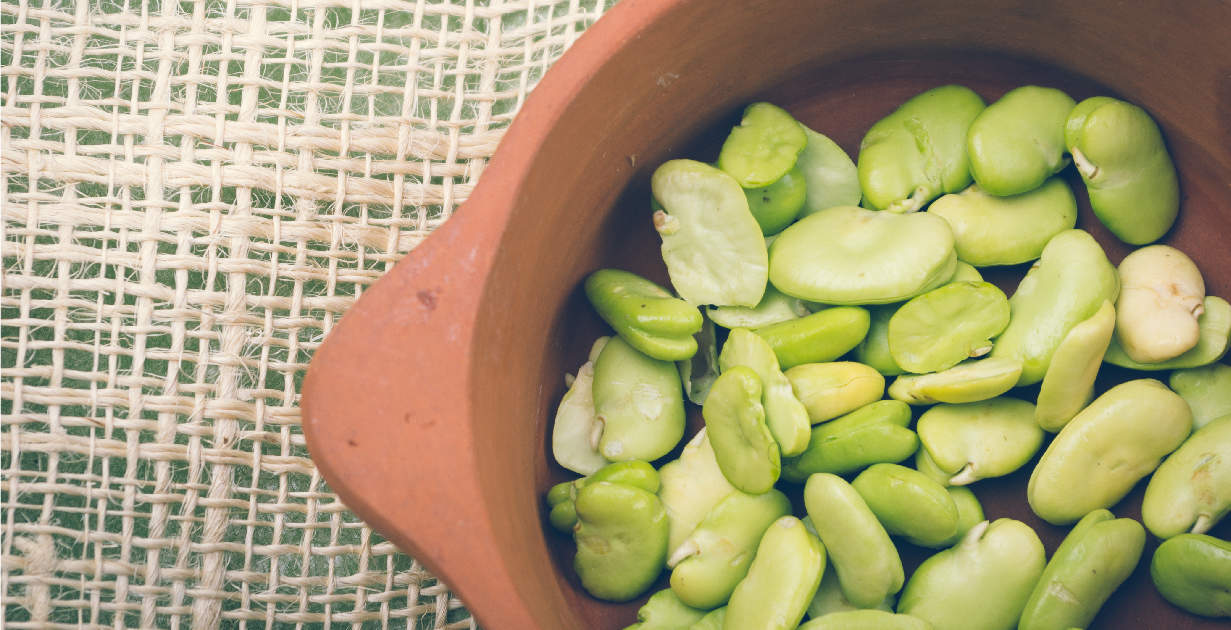Introduction To Lima Beans And Fava Beans

Lima beans and fava beans are two popular legumes that are often used in various cuisines around the world. Lima beans, also known as butter beans, are small, creamy beans that originated in Central and South America. They have a delicate flavor and buttery texture, making them a versatile ingredient in both savory and sweet dishes. On the other hand, fava beans, also called broad beans, have a more robust flavor and a slightly grainy texture. They have a long history and are widely consumed in Mediterranean and Middle Eastern cuisines. Both legumes offer a range of nutritional benefits and can be incorporated into a variety of dishes.
Description And Origin Of Lima Beans
Lima beans, also known as butter beans, are small, creamy beans that have a delicate flavor and a buttery texture. They are native to Central and South America and have been cultivated for centuries. Lima beans are oval-shaped and come in various colors, including white, green, and speckled. They are a popular ingredient in many cuisines around the world and are often used in soups, stews, salads, and side dishes. Lima beans are known for their high protein and fiber content, as well as their abundance of vitamins and minerals.
Description And Origin Of Fava Beans
Fava beans, also known as broad beans, are large, flat beans that have a distinct earthy flavor and smooth texture. They are native to the Mediterranean region and have been grown for thousands of years. Fava beans are enclosed in a thick, leathery pod and have a creamy, buttery color. They are often used in Mediterranean and Middle Eastern cuisines, where they are enjoyed in soups, stews, salads, and as a side dish. Fava beans are a good source of protein, fiber, and various vitamins and minerals.
Nutritional Comparison

When comparing the nutritional content of Lima beans and Fava beans, it’s clear that both legumes offer a range of essential nutrients. However, there are some notable differences. Lima beans are a good source of vitamins A and C, while Fava beans are rich in vitamin B6. In terms of minerals, Fava beans contain higher levels of protein, potassium, and magnesium compared to Lima beans. Additionally, Fava beans have a higher folate content. Both legumes provide valuable nutrients, making them excellent additions to a balanced diet.
Nutritional Value Of Lima Beans
Lima beans are packed with essential nutrients that contribute to overall health and well-being. They are a great source of vitamins A and C, which play a crucial role in supporting immune function and promoting healthy skin. Lima beans also provide a good amount of protein, fiber, and minerals such as potassium and magnesium. These legumes are low in fat and cholesterol, making them a nutritious option for those looking to maintain a balanced diet. Incorporating Lima beans into meals can provide a range of health benefits and contribute to a well-rounded nutritional intake.
Nutritional Value Of Fava Beans
Fava beans are highly nutritious legumes that offer a range of health benefits. They are a rich source of protein, providing 26.12g per 100g serving, making them an excellent choice for vegetarians and vegans. Fava beans are also high in potassium, with 1062mg per 100g, which supports heart health and helps regulate blood pressure. Additionally, they are packed with dietary fiber, offering 5.1 times more fiber than Lima beans. Fava beans are also a good source of folate and vitamin B6. Incorporating fava beans into your diet can contribute to a well-rounded and nutrient-dense eating plan.
Cooking And Culinary Uses

Fava beans and lima beans each have their distinct culinary uses. Fava beans are commonly used in Italian and North African cuisines. They can be boiled and used in salads, pureed for dips, or incorporated into stews and soups. On the other hand, lima beans are popular in South American and Caribbean cooking. They are often used in soups and stews, and can also be mashed and made into spreads or added to rice dishes. Both beans offer versatility in the kitchen and can be used in a variety of dishes to add flavor, texture, and nutrition.
Cooking Methods For Lima Beans
Lima beans can be cooked in a variety of ways to enhance their flavor and texture. They can be boiled in water or broth until tender, which takes about 15-20 minutes. Lima beans can also be sautéed with olive oil and seasonings for a delicious side dish. Additionally, they can be baked or roasted to bring out a nutty flavor. Lima beans are also commonly used in soups and stews, adding a hearty and creamy element to the dish. Regardless of the cooking method, it is important to ensure that the beans are fully cooked and soft before consuming them.
Cooking Methods For Fava Beans
Fava beans can be prepared in a variety of ways to bring out their unique flavor and texture. One popular method is to blanch the beans by boiling them briefly and then transferring them to an ice bath to cool. This helps to loosen the tough outer skin, which can be easily peeled off to reveal the bright green bean inside. Fava beans can also be sautéed with garlic and olive oil for a simple and tasty side dish. Additionally, they can be added to soups, stews, and salads for added protein and a burst of flavor.
Health Benefits And Potential Concerns

Fava beans and Lima beans offer several health benefits. Both legumes are rich in fiber, which aids digestion and promotes bowel regularity. They are also good sources of plant-based protein, making them an excellent option for vegetarians and vegans. Fava beans are known for their high folate content, which is important for pregnant women to support fetal development. However, it is important to note that some individuals may experience allergic reactions to fava beans, and people with G6PD deficiency should avoid consuming them. Additionally, both beans may cause gas and bloating in some individuals. Therefore, it is recommended to start with small portions and gradually increase consumption to avoid discomfort.
Health Benefits Of Consuming Lima Beans
Lima beans offer several health benefits. They are a good source of dietary fiber, which aids in digestion and promotes bowel regularity. The high fiber content also helps in maintaining a healthy weight and reducing the risk of chronic diseases such as heart disease and diabetes. Lima beans are also rich in folate, a nutrient essential for the production of red blood cells and DNA synthesis. Additionally, they provide a good amount of plant-based protein, making them a nutritious option for vegetarians and vegans.
Health Benefits Of Consuming Fava Beans
Fava beans offer numerous health benefits. They are a rich source of protein, with 3.82 times more protein per 100g compared to lima beans. This makes them an excellent choice for vegetarians and vegans looking to meet their protein needs. Fava beans are also high in potassium and magnesium, essential minerals that support heart health and help regulate blood pressure. Furthermore, they contain a significant amount of dietary fiber, promoting healthy digestion and preventing constipation. Fava beans are also a good source of folate, an important nutrient for pregnant women as it aids in fetal development. With their nutrient-packed profile, fava beans are a nutritious addition to any diet.
Potential Concerns Or Side Effects

Potential concerns or side effects associated with Lima beans and Fava beans are relatively minimal. However, it is important to note that both beans contain a type of sugar called raffinose, which can cause gas and bloating in some individuals. This can be mitigated by soaking the beans overnight and cooking them thoroughly. Additionally, individuals who have a G6PD deficiency should avoid consuming Fava beans, as they can cause a certain type of anemia. As with any food, it is always recommended to consume beans in moderation and listen to your body’s reactions.
Taste And Texture
Taste and texture play a significant role in distinguishing lima beans from fava beans. Lima beans have a slightly nutty and buttery flavor, with a creamy yet firm texture. In contrast, fava beans have a milder and earthier taste, often described as nutty or slightly sweet. Their texture is smooth and velvety, as their thin skin breaks down easily when cooked. The difference in taste and texture allows for a diverse range of culinary applications and adds variety to dishes.
Taste Profiles Of Lima Beans
Lima beans have a unique taste profile that is characterized by its mild and subtle flavors. These legumes have a slightly nutty undertone with hints of sweetness, making them appealing to a wide range of palates. The flavor is not overpowering, allowing the taste of other ingredients to shine in dishes. Lima beans have a delicate and creamy texture that adds a smooth and velvety quality to recipes. Whether used in soups, stews, or salads, lima beans provide a comforting and satisfying taste experience.
Taste Profiles Of Fava Beans

Fava beans have a distinct taste profile that is often described as nutty, earthy, and creamy. They have a lightly grassy flavor that is reminiscent of other legumes like chickpeas. Additionally, some people note that fava beans have a subtle hint of sweetness. However, it is important to note that fava beans can become bitter if they are overcooked or past their prime. Overall, the taste of fava beans adds richness and depth to dishes, making them a popular choice in salads, side dishes, and other culinary creations.
Texture Comparison
The texture of fava beans and lima beans differs significantly. Fava beans are known for their smooth texture, thanks to their thin skin that softens and breaks down easily when cooked. On the other hand, lima beans have a slightly chewier texture, as their skin is slightly thicker and holds its shape during cooking. This difference in texture makes fava beans a popular choice for creating creamy and velvety dishes, while lima beans are often used in soups and stews to add a hearty bite.
Conclusion
In conclusion, while both Lima beans and Fava beans are nutritious and versatile legumes, they have distinct differences in taste, texture, and culinary uses. Lima beans offer a creamier and milder flavor, making them ideal for soups and stews. Fava beans, on the other hand, have a distinctive nutty taste and a smooth texture, perfect for creating velvety purees and dips. When it comes to health benefits, both beans provide essential nutrients and contribute to a healthy diet. Ultimately, the choice between Lima beans and Fava beans depends on personal preference and desired culinary application.
Final Thoughts On Lima Beans Vs Fava Beans

When comparing Lima beans and Fava beans, it’s clear that they have their own unique qualities and uses in the culinary world. Lima beans offer a creamy texture and milder flavor, making them a great addition to soups and stews. Fava beans, on the other hand, have a nutty taste and smooth texture that is perfect for creating purees and dips. Both beans provide essential nutrients and contribute to a healthy diet. Ultimately, the choice between Lima beans and Fava beans depends on personal preference and desired culinary application.
Recipe Ideas And Serving Suggestions
When it comes to incorporating Lima beans and Fava beans into your culinary creations, the possibilities are endless. For Lima beans, you can use them as a base for hearty soups and stews, or mash them up and spread them onto crusty bread for a delicious bruschetta topping. They also work well in salads, mixed with fresh vegetables and a tangy vinaigrette. As for Fava beans, you can puree them into a creamy dip, blend them into a flavorful pesto, or toss them into pasta dishes for added texture. These beans are also great in Mediterranean-inspired salads with feta cheese and olives. Whichever legume you choose, Lima beans and Fava beans are versatile ingredients that can elevate any dish.
FAQ About Lima Beans Vs Fava Beans: Legume Showdown
Q: What are the main differences between Lima beans and Fava beans?
A: Lima beans are small, flat, and kidney-shaped with a buttery texture, while Fava beans are larger, oval-shaped, and have a slightly sweet flavor.
Q: How do the nutritional profiles of Lima beans and Fava beans compare?
A: Lima beans are rich in fiber, protein, and iron, while Fava beans contain more protein and fiber but are lower in calories and carbohydrates.
Q: Can Lima beans and Fava beans be used interchangeably in recipes?
A: Yes, both beans can be used in various dishes like soups, stews, salads, and side dishes. However, their texture and flavor differ, so they may not always be direct substitutes for each other.
Q: Are Lima beans and Fava beans suitable for individuals with dietary restrictions?
A: Both Lima beans and Fava beans are gluten-free and vegan-friendly, making them suitable for people with these dietary preferences. However, individuals with certain conditions like G6PD deficiency should avoid Fava beans.
Q: How should Lima beans and Fava beans be prepared for consumption?
A: Lima beans should be soaked and cooked thoroughly to remove toxins, while Fava beans need to be shelled twice before cooking due to their tough outer skin.
Q: Which bean is more commonly found in supermarkets, Lima beans, or Fava beans?
A: Lima beans are more readily available in supermarkets in various forms like fresh, frozen, canned, or dried compared to Fava beans, which are less common and mostly found in specialty stores or markets.

Lenoir’s Bistro & Bakery, a charming and chic cafe, has been delighting patrons with an array of delectable delights since its inception. From mouthwatering breakfast bites to succulent burgers and sandwiches and a tempting selection of pasta, sides, and desserts, Lenoir’s Bistro & Bakery is the go-to destination for food enthusiasts seeking a delightful dining experience. Founded by a passionate culinary team with a vision to create a welcoming and stylish eatery, Lenoir’s Bistro & Bakery has seamlessly blended the art of baking with the craft of preparing savory dishes. The result is a menu that caters to diverse tastes and preferences, offering something to satisfy every craving.